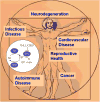Lyase to live by: sphingosine phosphate lyase as a therapeutic target
- PMID: 19534571
- PMCID: PMC2774446
- DOI: 10.1517/14728220903039722
Lyase to live by: sphingosine phosphate lyase as a therapeutic target
Abstract
Background: Sphingosine 1-phosphate (S1P) is a bioactive lipid that regulates cell proliferation, survival and migration and plays an essential role in angiogenesis and lymphocyte trafficking. S1P levels in the circulation and tissues are tightly regulated for proper cell functioning, and dysregulation of this system may contribute to the pathophysiology of certain human diseases. Sphingosine phosphate lyase (SPL) irreversibly degrades S1P and thereby acts as a gatekeeper that regulates S1P signaling by modulating intracellular S1P levels and the chemical S1P gradient that exists between lymphoid organs and circulating blood and lymph. However, SPL also generates biochemical products that may be relevant in human disease. SPL has been directly implicated in various physiological and pathological processes, including cell stress responses, cancer, immunity, hematopoietic function, muscle homeostasis, inflammation and development.
Objective/methods: This review summarizes the current know-ledge of SPL structure, function and regulation, its involvement in various disease states and currently available small molecules known to modulate SPL activity.
Results/conclusion: This review provides evidence that SPL is a potential target for pharmacological manipulation for the treatment of malignant, autoimmune, inflammatory and other diseases.
Figures


References
-
- Alvarez SE, Milstien S, Spiegel S. Autocrine and paracrine roles of sphingosine-1-phosphate. Trends Endocrinol Metab. 2007 Oct;18(8):300–7. - PubMed
-
- Lee MJ, Van Brocklyn JR, Thangada S, Liu C, Hand A, Menzeleev R, et al. Sphingosine-1-phosphate as a ligand for the G protein-coupled receptor EDG-1. Science. 1998;279(5356):1552–5. A pivotal study that identified G-protein coupled receptor (Endothelial Differentiation Gene-1) as first S1Preceptor. - PubMed
Publication types
MeSH terms
Substances
Grants and funding
LinkOut - more resources
Full Text Sources
Other Literature Sources
